Emotional Intelligence: Leadership, Self-Reflection, and Case Analysis
VerifiedAdded on 2023/04/08
|10
|1294
|89
Essay
AI Summary
This essay examines the role of emotional intelligence (EI) in leadership, focusing on self-reflection and its impact on performance. It analyzes a case study where a project manager, Ahmed, experiences challenges due to increased pressure, leading to a decline in confidence. The analysis highlights the importance of EI competencies such as self-assessment, self-regulation, empathy, effective communication, and relationship management for effective leadership. The essay also discusses Gardner’s theory of multiple intelligences and the significance of fostering EI to build and maintain successful relationships, emphasizing skills like stress management, emotional recognition, and conflict resolution. Furthermore, it touches upon the importance of communication training and inclusive policies in the workplace to prevent cultural misunderstandings and support new employees.
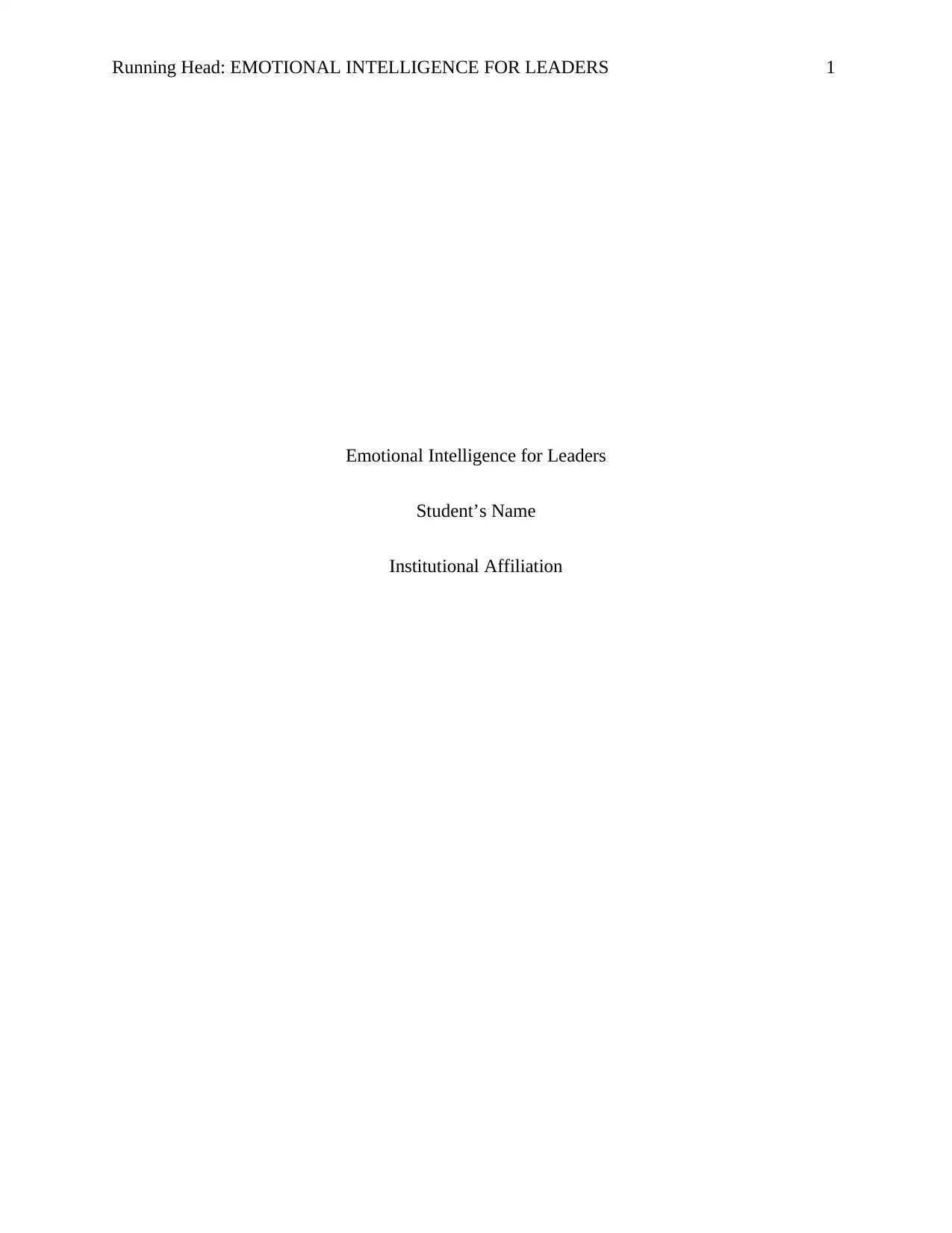
Running Head: EMOTIONAL INTELLIGENCE FOR LEADERS 1
Emotional Intelligence for Leaders
Student’s Name
Institutional Affiliation
Emotional Intelligence for Leaders
Student’s Name
Institutional Affiliation
Paraphrase This Document
Need a fresh take? Get an instant paraphrase of this document with our AI Paraphraser
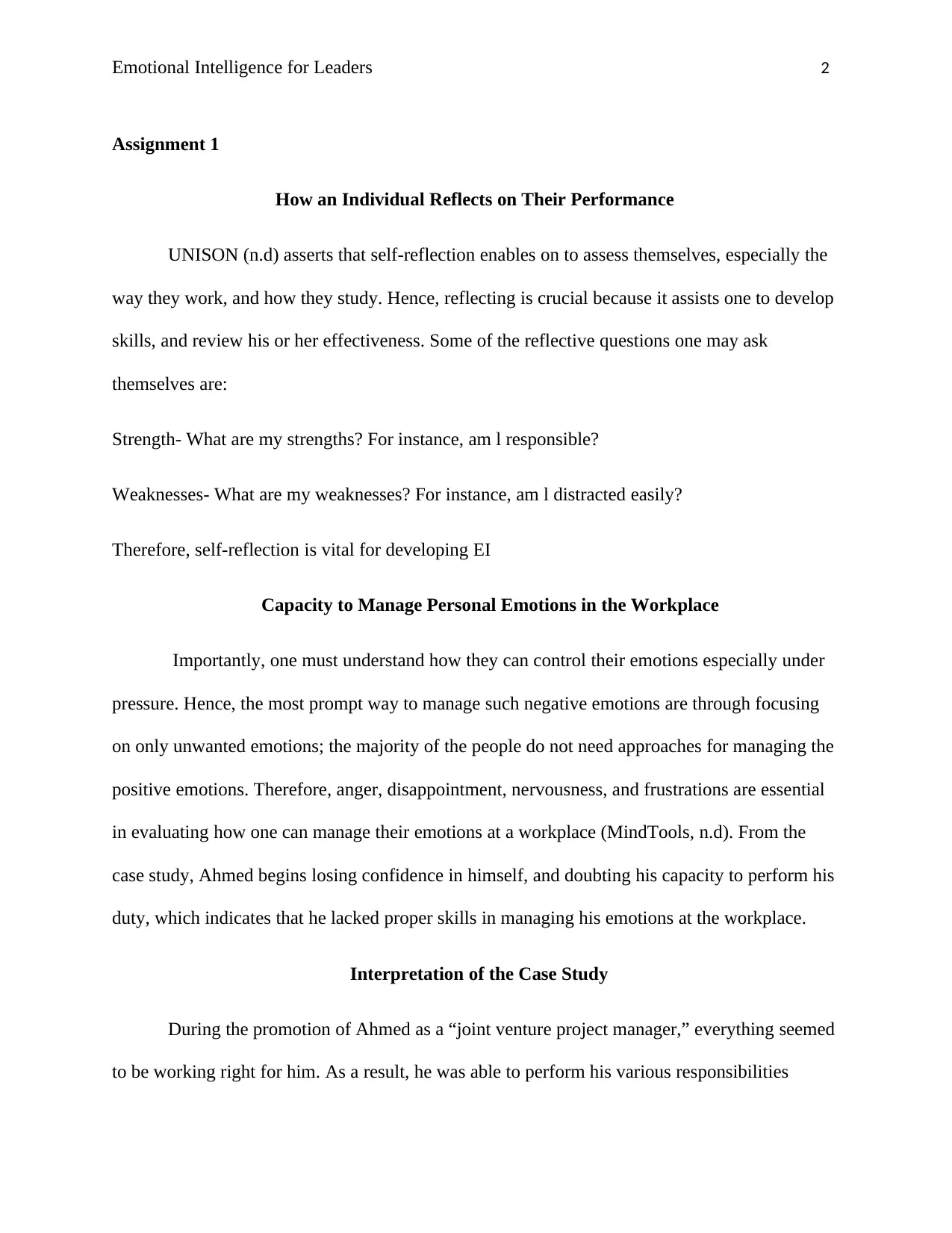
Emotional Intelligence for Leaders 2
Assignment 1
How an Individual Reflects on Their Performance
UNISON (n.d) asserts that self-reflection enables on to assess themselves, especially the
way they work, and how they study. Hence, reflecting is crucial because it assists one to develop
skills, and review his or her effectiveness. Some of the reflective questions one may ask
themselves are:
Strength- What are my strengths? For instance, am l responsible?
Weaknesses- What are my weaknesses? For instance, am l distracted easily?
Therefore, self-reflection is vital for developing EI
Capacity to Manage Personal Emotions in the Workplace
Importantly, one must understand how they can control their emotions especially under
pressure. Hence, the most prompt way to manage such negative emotions are through focusing
on only unwanted emotions; the majority of the people do not need approaches for managing the
positive emotions. Therefore, anger, disappointment, nervousness, and frustrations are essential
in evaluating how one can manage their emotions at a workplace (MindTools, n.d). From the
case study, Ahmed begins losing confidence in himself, and doubting his capacity to perform his
duty, which indicates that he lacked proper skills in managing his emotions at the workplace.
Interpretation of the Case Study
During the promotion of Ahmed as a “joint venture project manager,” everything seemed
to be working right for him. As a result, he was able to perform his various responsibilities
Assignment 1
How an Individual Reflects on Their Performance
UNISON (n.d) asserts that self-reflection enables on to assess themselves, especially the
way they work, and how they study. Hence, reflecting is crucial because it assists one to develop
skills, and review his or her effectiveness. Some of the reflective questions one may ask
themselves are:
Strength- What are my strengths? For instance, am l responsible?
Weaknesses- What are my weaknesses? For instance, am l distracted easily?
Therefore, self-reflection is vital for developing EI
Capacity to Manage Personal Emotions in the Workplace
Importantly, one must understand how they can control their emotions especially under
pressure. Hence, the most prompt way to manage such negative emotions are through focusing
on only unwanted emotions; the majority of the people do not need approaches for managing the
positive emotions. Therefore, anger, disappointment, nervousness, and frustrations are essential
in evaluating how one can manage their emotions at a workplace (MindTools, n.d). From the
case study, Ahmed begins losing confidence in himself, and doubting his capacity to perform his
duty, which indicates that he lacked proper skills in managing his emotions at the workplace.
Interpretation of the Case Study
During the promotion of Ahmed as a “joint venture project manager,” everything seemed
to be working right for him. As a result, he was able to perform his various responsibilities
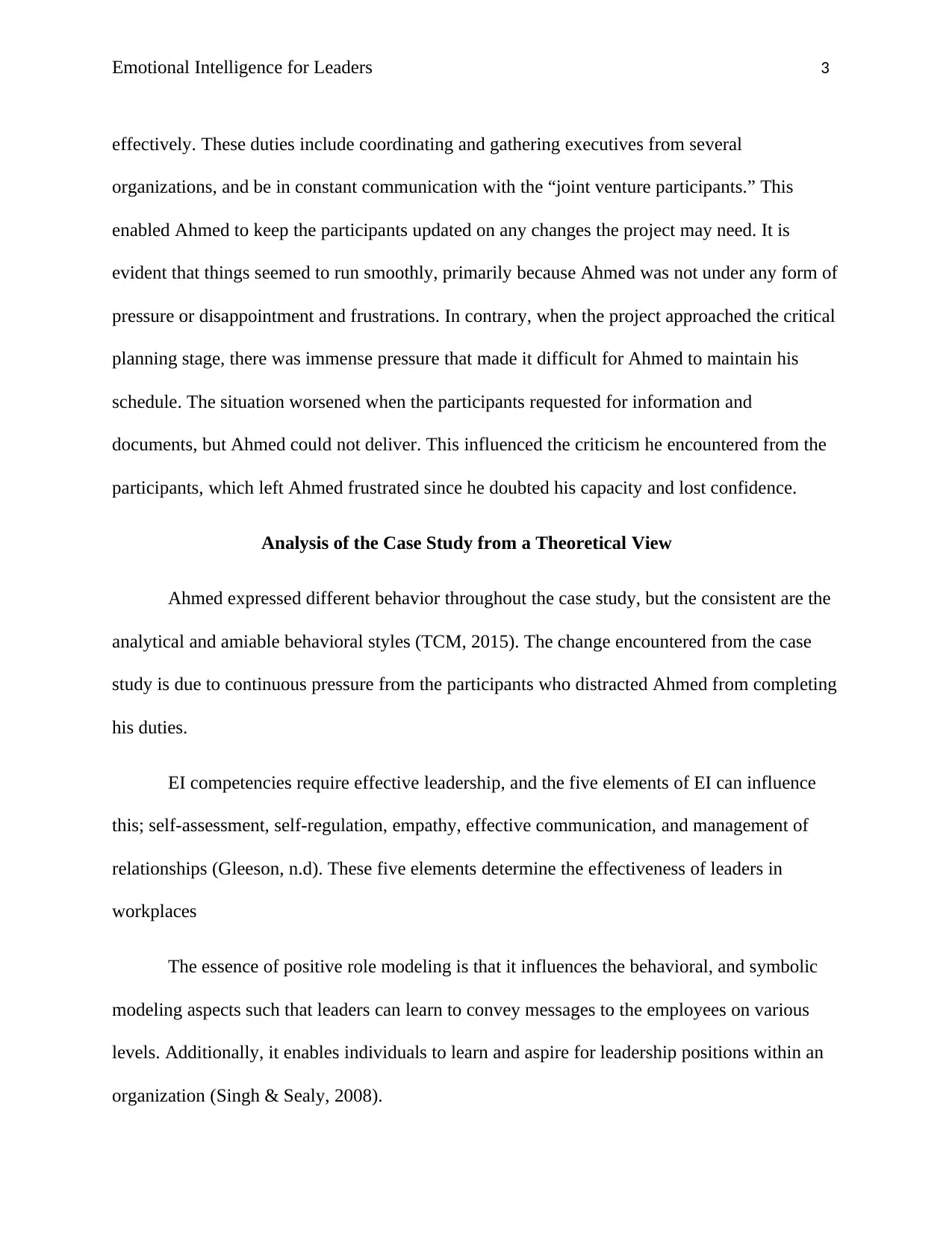
Emotional Intelligence for Leaders 3
effectively. These duties include coordinating and gathering executives from several
organizations, and be in constant communication with the “joint venture participants.” This
enabled Ahmed to keep the participants updated on any changes the project may need. It is
evident that things seemed to run smoothly, primarily because Ahmed was not under any form of
pressure or disappointment and frustrations. In contrary, when the project approached the critical
planning stage, there was immense pressure that made it difficult for Ahmed to maintain his
schedule. The situation worsened when the participants requested for information and
documents, but Ahmed could not deliver. This influenced the criticism he encountered from the
participants, which left Ahmed frustrated since he doubted his capacity and lost confidence.
Analysis of the Case Study from a Theoretical View
Ahmed expressed different behavior throughout the case study, but the consistent are the
analytical and amiable behavioral styles (TCM, 2015). The change encountered from the case
study is due to continuous pressure from the participants who distracted Ahmed from completing
his duties.
EI competencies require effective leadership, and the five elements of EI can influence
this; self-assessment, self-regulation, empathy, effective communication, and management of
relationships (Gleeson, n.d). These five elements determine the effectiveness of leaders in
workplaces
The essence of positive role modeling is that it influences the behavioral, and symbolic
modeling aspects such that leaders can learn to convey messages to the employees on various
levels. Additionally, it enables individuals to learn and aspire for leadership positions within an
organization (Singh & Sealy, 2008).
effectively. These duties include coordinating and gathering executives from several
organizations, and be in constant communication with the “joint venture participants.” This
enabled Ahmed to keep the participants updated on any changes the project may need. It is
evident that things seemed to run smoothly, primarily because Ahmed was not under any form of
pressure or disappointment and frustrations. In contrary, when the project approached the critical
planning stage, there was immense pressure that made it difficult for Ahmed to maintain his
schedule. The situation worsened when the participants requested for information and
documents, but Ahmed could not deliver. This influenced the criticism he encountered from the
participants, which left Ahmed frustrated since he doubted his capacity and lost confidence.
Analysis of the Case Study from a Theoretical View
Ahmed expressed different behavior throughout the case study, but the consistent are the
analytical and amiable behavioral styles (TCM, 2015). The change encountered from the case
study is due to continuous pressure from the participants who distracted Ahmed from completing
his duties.
EI competencies require effective leadership, and the five elements of EI can influence
this; self-assessment, self-regulation, empathy, effective communication, and management of
relationships (Gleeson, n.d). These five elements determine the effectiveness of leaders in
workplaces
The essence of positive role modeling is that it influences the behavioral, and symbolic
modeling aspects such that leaders can learn to convey messages to the employees on various
levels. Additionally, it enables individuals to learn and aspire for leadership positions within an
organization (Singh & Sealy, 2008).
⊘ This is a preview!⊘
Do you want full access?
Subscribe today to unlock all pages.

Trusted by 1+ million students worldwide
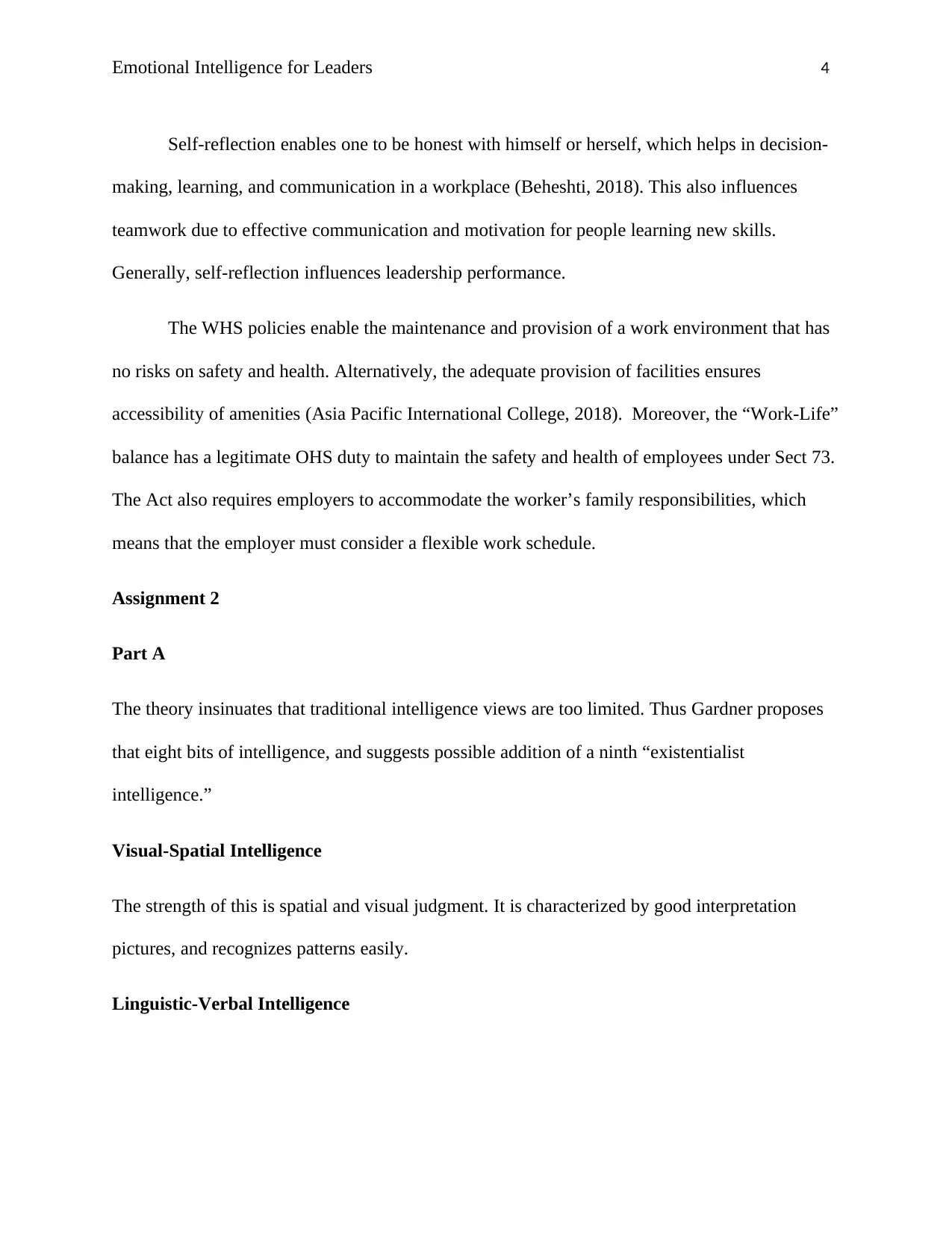
Emotional Intelligence for Leaders 4
Self-reflection enables one to be honest with himself or herself, which helps in decision-
making, learning, and communication in a workplace (Beheshti, 2018). This also influences
teamwork due to effective communication and motivation for people learning new skills.
Generally, self-reflection influences leadership performance.
The WHS policies enable the maintenance and provision of a work environment that has
no risks on safety and health. Alternatively, the adequate provision of facilities ensures
accessibility of amenities (Asia Pacific International College, 2018). Moreover, the “Work-Life”
balance has a legitimate OHS duty to maintain the safety and health of employees under Sect 73.
The Act also requires employers to accommodate the worker’s family responsibilities, which
means that the employer must consider a flexible work schedule.
Assignment 2
Part A
The theory insinuates that traditional intelligence views are too limited. Thus Gardner proposes
that eight bits of intelligence, and suggests possible addition of a ninth “existentialist
intelligence.”
Visual-Spatial Intelligence
The strength of this is spatial and visual judgment. It is characterized by good interpretation
pictures, and recognizes patterns easily.
Linguistic-Verbal Intelligence
Self-reflection enables one to be honest with himself or herself, which helps in decision-
making, learning, and communication in a workplace (Beheshti, 2018). This also influences
teamwork due to effective communication and motivation for people learning new skills.
Generally, self-reflection influences leadership performance.
The WHS policies enable the maintenance and provision of a work environment that has
no risks on safety and health. Alternatively, the adequate provision of facilities ensures
accessibility of amenities (Asia Pacific International College, 2018). Moreover, the “Work-Life”
balance has a legitimate OHS duty to maintain the safety and health of employees under Sect 73.
The Act also requires employers to accommodate the worker’s family responsibilities, which
means that the employer must consider a flexible work schedule.
Assignment 2
Part A
The theory insinuates that traditional intelligence views are too limited. Thus Gardner proposes
that eight bits of intelligence, and suggests possible addition of a ninth “existentialist
intelligence.”
Visual-Spatial Intelligence
The strength of this is spatial and visual judgment. It is characterized by good interpretation
pictures, and recognizes patterns easily.
Linguistic-Verbal Intelligence
Paraphrase This Document
Need a fresh take? Get an instant paraphrase of this document with our AI Paraphraser
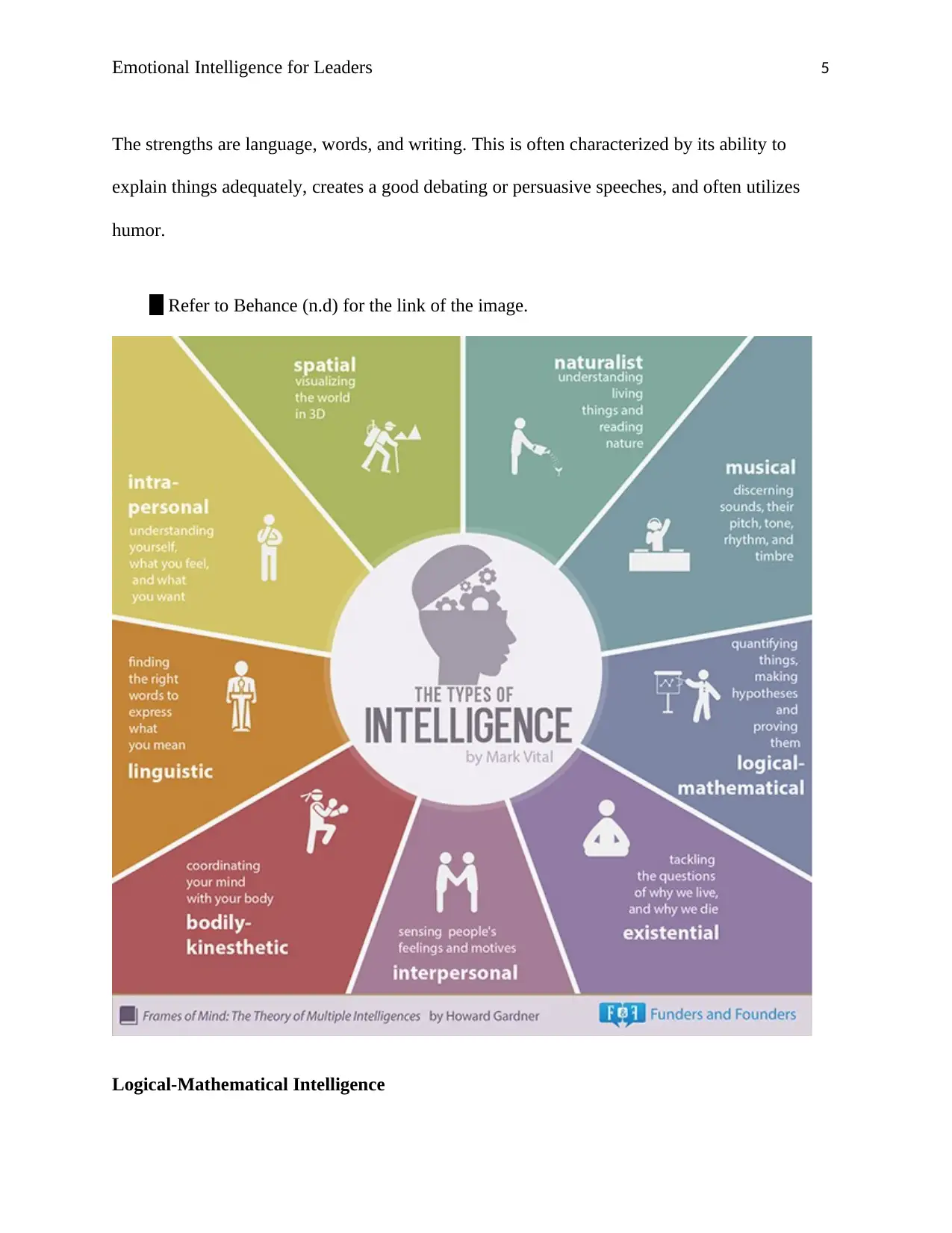
Emotional Intelligence for Leaders 5
The strengths are language, words, and writing. This is often characterized by its ability to
explain things adequately, creates a good debating or persuasive speeches, and often utilizes
humor.
Refer to Behance (n.d) for the link of the image.
Logical-Mathematical Intelligence
The strengths are language, words, and writing. This is often characterized by its ability to
explain things adequately, creates a good debating or persuasive speeches, and often utilizes
humor.
Refer to Behance (n.d) for the link of the image.
Logical-Mathematical Intelligence
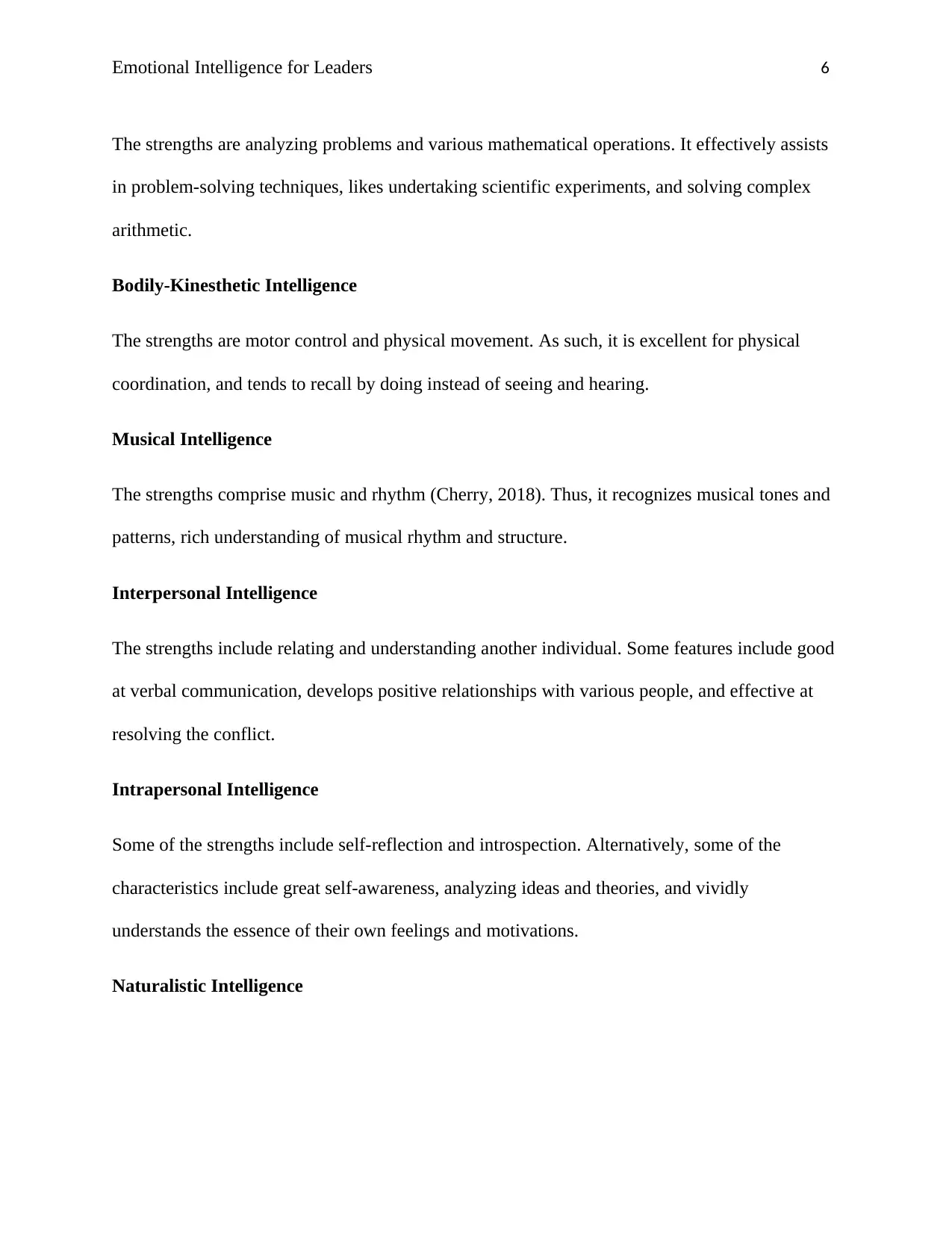
Emotional Intelligence for Leaders 6
The strengths are analyzing problems and various mathematical operations. It effectively assists
in problem-solving techniques, likes undertaking scientific experiments, and solving complex
arithmetic.
Bodily-Kinesthetic Intelligence
The strengths are motor control and physical movement. As such, it is excellent for physical
coordination, and tends to recall by doing instead of seeing and hearing.
Musical Intelligence
The strengths comprise music and rhythm (Cherry, 2018). Thus, it recognizes musical tones and
patterns, rich understanding of musical rhythm and structure.
Interpersonal Intelligence
The strengths include relating and understanding another individual. Some features include good
at verbal communication, develops positive relationships with various people, and effective at
resolving the conflict.
Intrapersonal Intelligence
Some of the strengths include self-reflection and introspection. Alternatively, some of the
characteristics include great self-awareness, analyzing ideas and theories, and vividly
understands the essence of their own feelings and motivations.
Naturalistic Intelligence
The strengths are analyzing problems and various mathematical operations. It effectively assists
in problem-solving techniques, likes undertaking scientific experiments, and solving complex
arithmetic.
Bodily-Kinesthetic Intelligence
The strengths are motor control and physical movement. As such, it is excellent for physical
coordination, and tends to recall by doing instead of seeing and hearing.
Musical Intelligence
The strengths comprise music and rhythm (Cherry, 2018). Thus, it recognizes musical tones and
patterns, rich understanding of musical rhythm and structure.
Interpersonal Intelligence
The strengths include relating and understanding another individual. Some features include good
at verbal communication, develops positive relationships with various people, and effective at
resolving the conflict.
Intrapersonal Intelligence
Some of the strengths include self-reflection and introspection. Alternatively, some of the
characteristics include great self-awareness, analyzing ideas and theories, and vividly
understands the essence of their own feelings and motivations.
Naturalistic Intelligence
⊘ This is a preview!⊘
Do you want full access?
Subscribe today to unlock all pages.

Trusted by 1+ million students worldwide
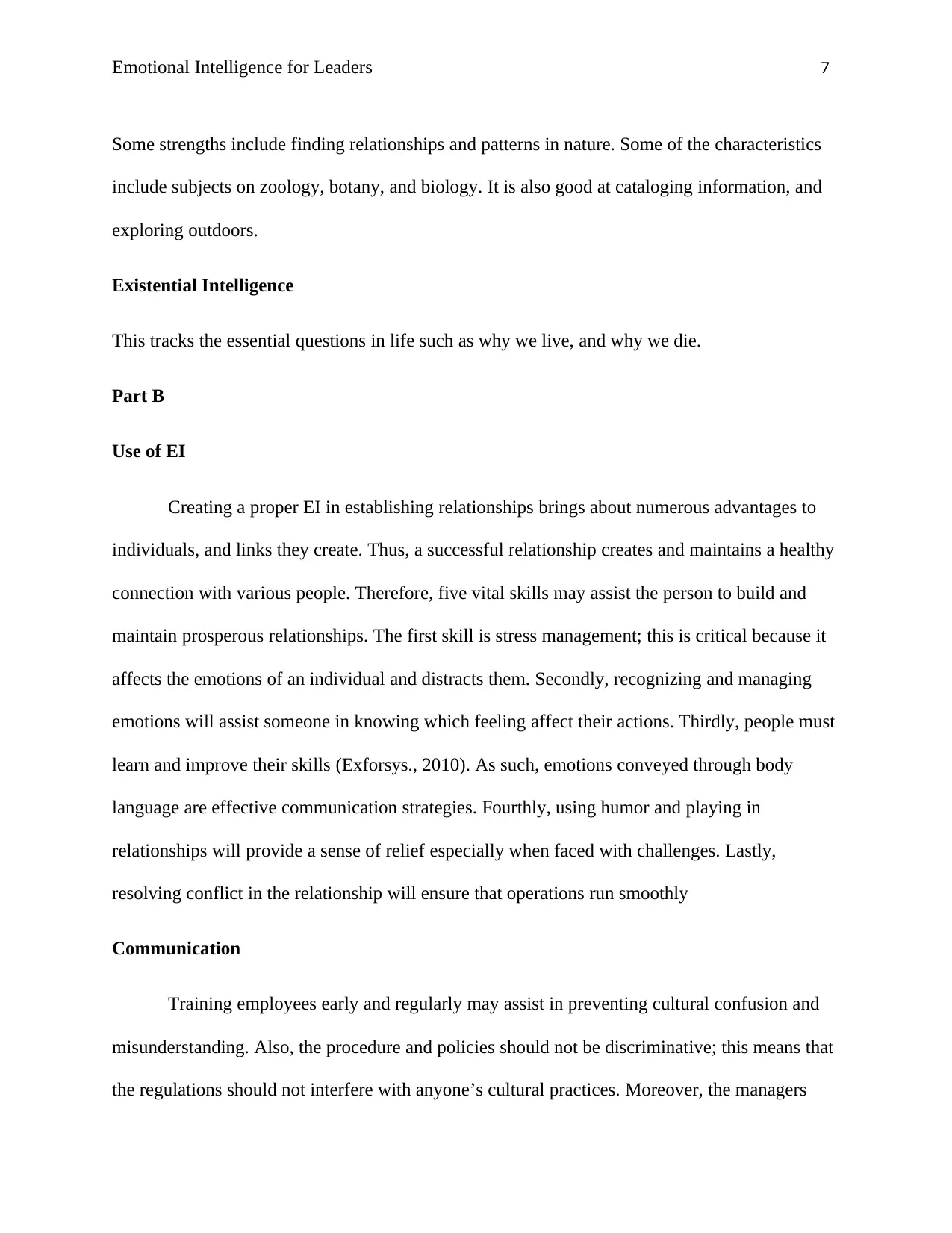
Emotional Intelligence for Leaders 7
Some strengths include finding relationships and patterns in nature. Some of the characteristics
include subjects on zoology, botany, and biology. It is also good at cataloging information, and
exploring outdoors.
Existential Intelligence
This tracks the essential questions in life such as why we live, and why we die.
Part B
Use of EI
Creating a proper EI in establishing relationships brings about numerous advantages to
individuals, and links they create. Thus, a successful relationship creates and maintains a healthy
connection with various people. Therefore, five vital skills may assist the person to build and
maintain prosperous relationships. The first skill is stress management; this is critical because it
affects the emotions of an individual and distracts them. Secondly, recognizing and managing
emotions will assist someone in knowing which feeling affect their actions. Thirdly, people must
learn and improve their skills (Exforsys., 2010). As such, emotions conveyed through body
language are effective communication strategies. Fourthly, using humor and playing in
relationships will provide a sense of relief especially when faced with challenges. Lastly,
resolving conflict in the relationship will ensure that operations run smoothly
Communication
Training employees early and regularly may assist in preventing cultural confusion and
misunderstanding. Also, the procedure and policies should not be discriminative; this means that
the regulations should not interfere with anyone’s cultural practices. Moreover, the managers
Some strengths include finding relationships and patterns in nature. Some of the characteristics
include subjects on zoology, botany, and biology. It is also good at cataloging information, and
exploring outdoors.
Existential Intelligence
This tracks the essential questions in life such as why we live, and why we die.
Part B
Use of EI
Creating a proper EI in establishing relationships brings about numerous advantages to
individuals, and links they create. Thus, a successful relationship creates and maintains a healthy
connection with various people. Therefore, five vital skills may assist the person to build and
maintain prosperous relationships. The first skill is stress management; this is critical because it
affects the emotions of an individual and distracts them. Secondly, recognizing and managing
emotions will assist someone in knowing which feeling affect their actions. Thirdly, people must
learn and improve their skills (Exforsys., 2010). As such, emotions conveyed through body
language are effective communication strategies. Fourthly, using humor and playing in
relationships will provide a sense of relief especially when faced with challenges. Lastly,
resolving conflict in the relationship will ensure that operations run smoothly
Communication
Training employees early and regularly may assist in preventing cultural confusion and
misunderstanding. Also, the procedure and policies should not be discriminative; this means that
the regulations should not interfere with anyone’s cultural practices. Moreover, the managers
Paraphrase This Document
Need a fresh take? Get an instant paraphrase of this document with our AI Paraphraser
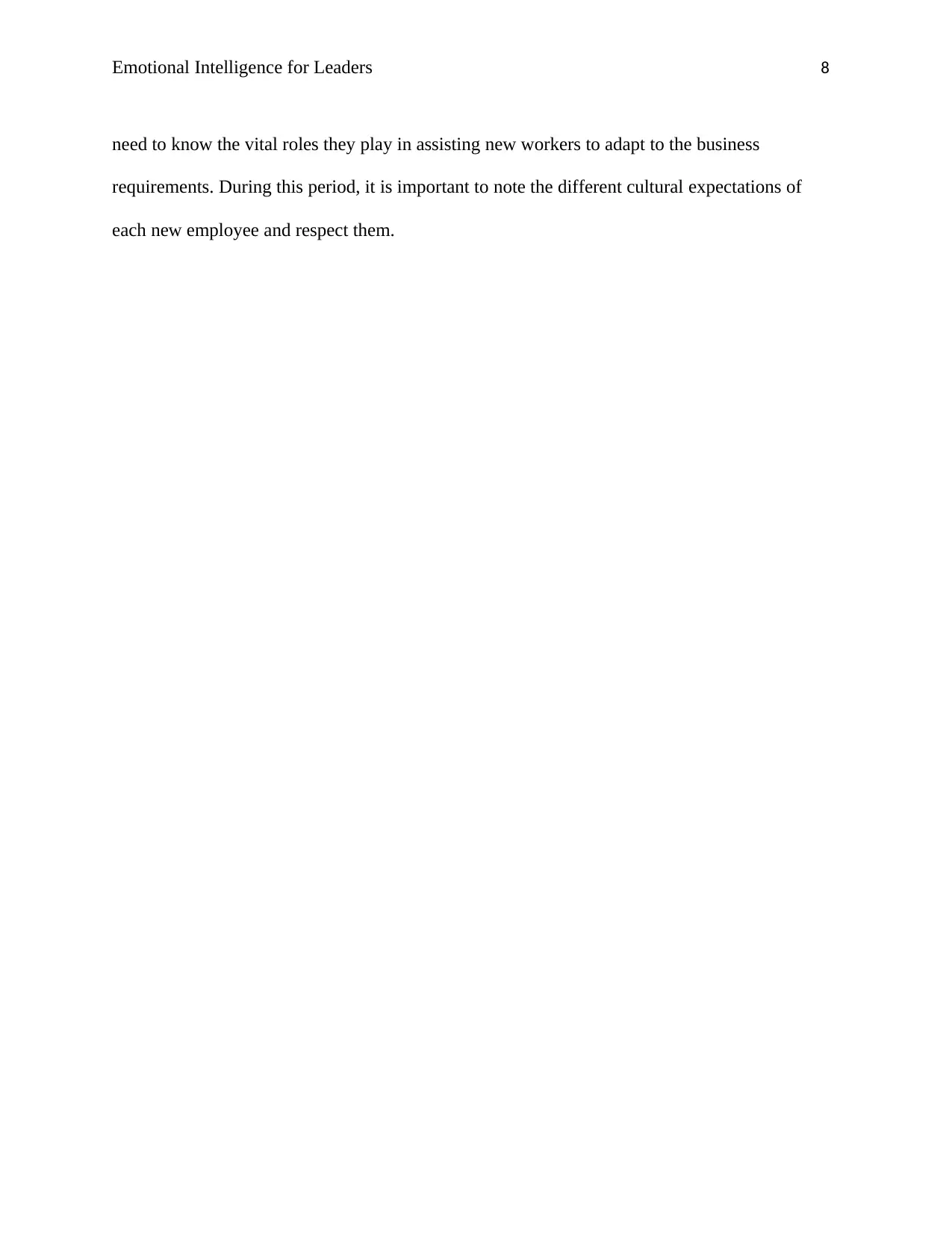
Emotional Intelligence for Leaders 8
need to know the vital roles they play in assisting new workers to adapt to the business
requirements. During this period, it is important to note the different cultural expectations of
each new employee and respect them.
need to know the vital roles they play in assisting new workers to adapt to the business
requirements. During this period, it is important to note the different cultural expectations of
each new employee and respect them.
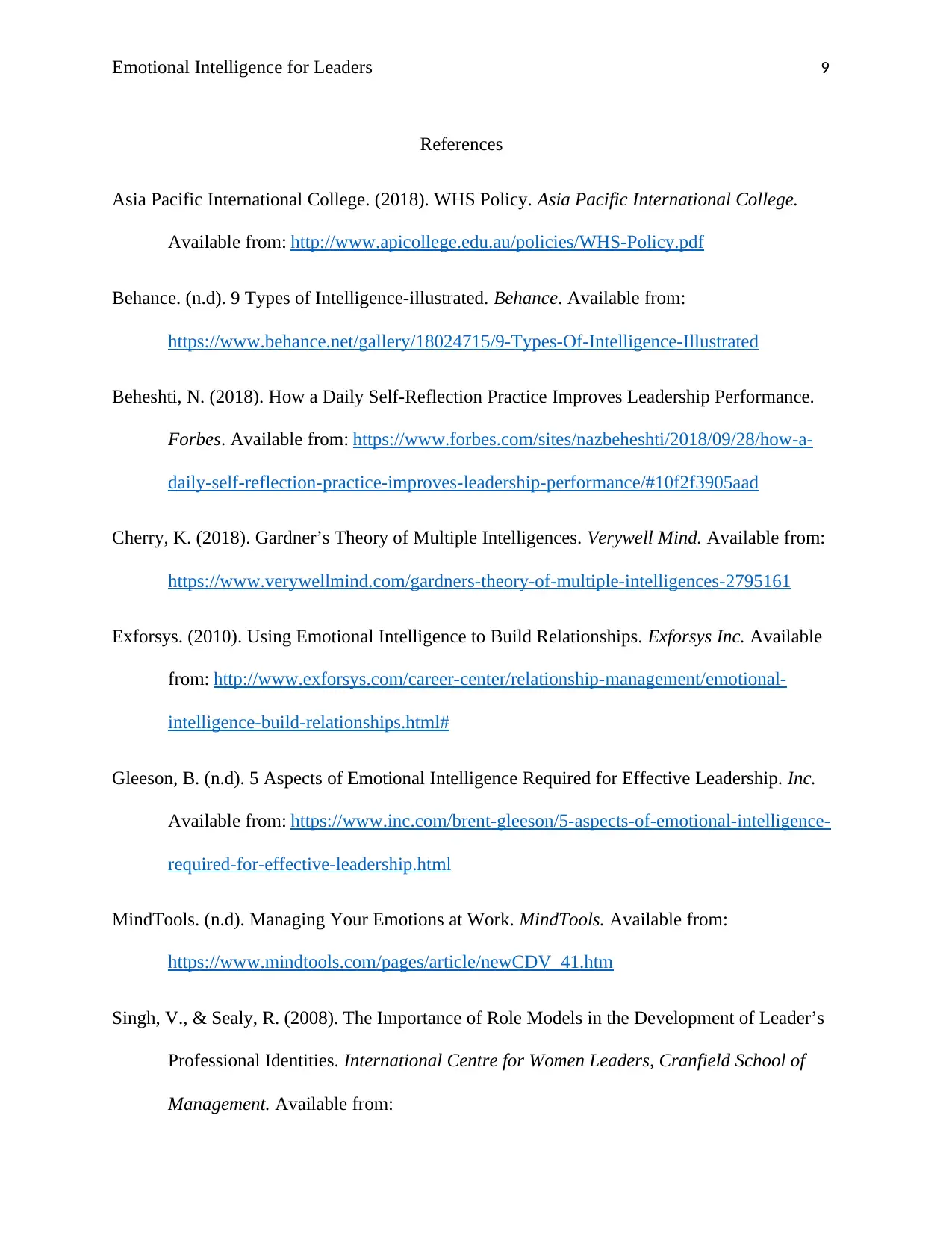
Emotional Intelligence for Leaders 9
References
Asia Pacific International College. (2018). WHS Policy. Asia Pacific International College.
Available from: http://www.apicollege.edu.au/policies/WHS-Policy.pdf
Behance. (n.d). 9 Types of Intelligence-illustrated. Behance. Available from:
https://www.behance.net/gallery/18024715/9-Types-Of-Intelligence-Illustrated
Beheshti, N. (2018). How a Daily Self-Reflection Practice Improves Leadership Performance.
Forbes. Available from: https://www.forbes.com/sites/nazbeheshti/2018/09/28/how-a-
daily-self-reflection-practice-improves-leadership-performance/#10f2f3905aad
Cherry, K. (2018). Gardner’s Theory of Multiple Intelligences. Verywell Mind. Available from:
https://www.verywellmind.com/gardners-theory-of-multiple-intelligences-2795161
Exforsys. (2010). Using Emotional Intelligence to Build Relationships. Exforsys Inc. Available
from: http://www.exforsys.com/career-center/relationship-management/emotional-
intelligence-build-relationships.html#
Gleeson, B. (n.d). 5 Aspects of Emotional Intelligence Required for Effective Leadership. Inc.
Available from: https://www.inc.com/brent-gleeson/5-aspects-of-emotional-intelligence-
required-for-effective-leadership.html
MindTools. (n.d). Managing Your Emotions at Work. MindTools. Available from:
https://www.mindtools.com/pages/article/newCDV_41.htm
Singh, V., & Sealy, R. (2008). The Importance of Role Models in the Development of Leader’s
Professional Identities. International Centre for Women Leaders, Cranfield School of
Management. Available from:
References
Asia Pacific International College. (2018). WHS Policy. Asia Pacific International College.
Available from: http://www.apicollege.edu.au/policies/WHS-Policy.pdf
Behance. (n.d). 9 Types of Intelligence-illustrated. Behance. Available from:
https://www.behance.net/gallery/18024715/9-Types-Of-Intelligence-Illustrated
Beheshti, N. (2018). How a Daily Self-Reflection Practice Improves Leadership Performance.
Forbes. Available from: https://www.forbes.com/sites/nazbeheshti/2018/09/28/how-a-
daily-self-reflection-practice-improves-leadership-performance/#10f2f3905aad
Cherry, K. (2018). Gardner’s Theory of Multiple Intelligences. Verywell Mind. Available from:
https://www.verywellmind.com/gardners-theory-of-multiple-intelligences-2795161
Exforsys. (2010). Using Emotional Intelligence to Build Relationships. Exforsys Inc. Available
from: http://www.exforsys.com/career-center/relationship-management/emotional-
intelligence-build-relationships.html#
Gleeson, B. (n.d). 5 Aspects of Emotional Intelligence Required for Effective Leadership. Inc.
Available from: https://www.inc.com/brent-gleeson/5-aspects-of-emotional-intelligence-
required-for-effective-leadership.html
MindTools. (n.d). Managing Your Emotions at Work. MindTools. Available from:
https://www.mindtools.com/pages/article/newCDV_41.htm
Singh, V., & Sealy, R. (2008). The Importance of Role Models in the Development of Leader’s
Professional Identities. International Centre for Women Leaders, Cranfield School of
Management. Available from:
⊘ This is a preview!⊘
Do you want full access?
Subscribe today to unlock all pages.

Trusted by 1+ million students worldwide
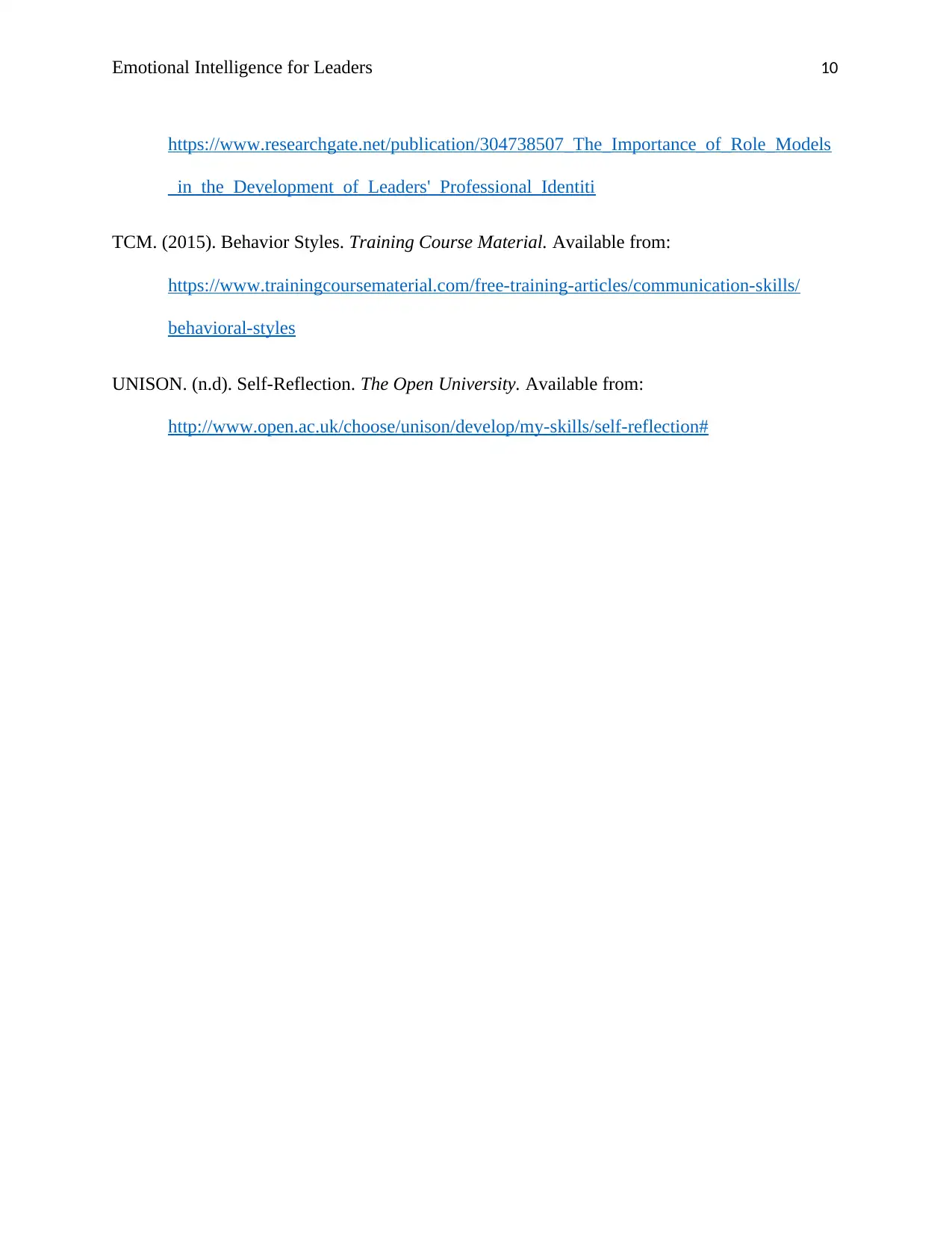
Emotional Intelligence for Leaders 10
https://www.researchgate.net/publication/304738507_The_Importance_of_Role_Models
_in_the_Development_of_Leaders'_Professional_Identiti
TCM. (2015). Behavior Styles. Training Course Material. Available from:
https://www.trainingcoursematerial.com/free-training-articles/communication-skills/
behavioral-styles
UNISON. (n.d). Self-Reflection. The Open University. Available from:
http://www.open.ac.uk/choose/unison/develop/my-skills/self-reflection#
https://www.researchgate.net/publication/304738507_The_Importance_of_Role_Models
_in_the_Development_of_Leaders'_Professional_Identiti
TCM. (2015). Behavior Styles. Training Course Material. Available from:
https://www.trainingcoursematerial.com/free-training-articles/communication-skills/
behavioral-styles
UNISON. (n.d). Self-Reflection. The Open University. Available from:
http://www.open.ac.uk/choose/unison/develop/my-skills/self-reflection#
1 out of 10
Related Documents
Your All-in-One AI-Powered Toolkit for Academic Success.
+13062052269
info@desklib.com
Available 24*7 on WhatsApp / Email
![[object Object]](/_next/static/media/star-bottom.7253800d.svg)
Unlock your academic potential
Copyright © 2020–2025 A2Z Services. All Rights Reserved. Developed and managed by ZUCOL.




